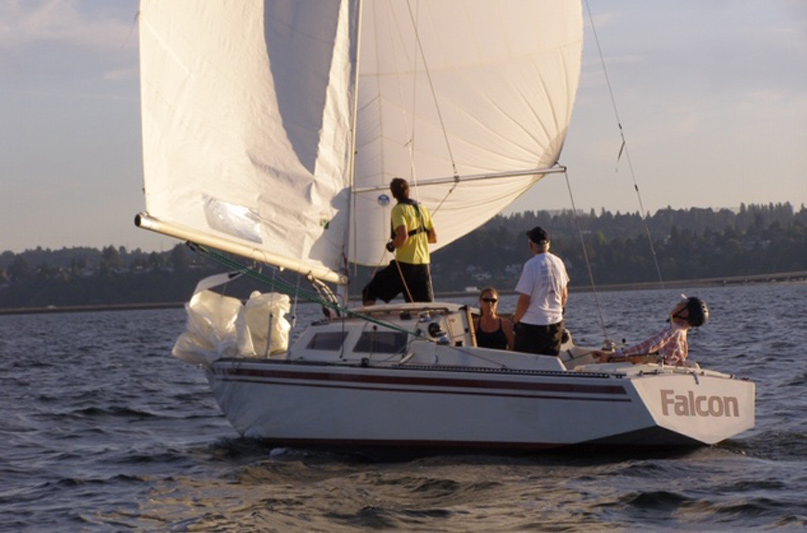Legendary Thunderbird sailor Sanders (Sandy) Pratt succumbed to COVID19 on March 26th. He is survived by two children and four grandchildren. Sandy’s daughter, Barbara, said that he was admitted to the hospital on Sunday, March 22 for the novel coronavirus. The cruelest part of this disease is that such a well-loved and respected man was forced to spend his last moments in isolation.
A strapping man who was 92 when he died, he remained a fierce competitor to the age of 90. He was a stalwart racer, aggressively maneuvering for room on the starting line. A member of Corinthian Yacht Club Seattle since 1957, he rarely missed a race. When I met him, more than 30 years ago, he was not a young man. Yet he never seemed to age, and when I last saw him, his laugh seemed just as hearty as always.
His love of sailing started around the age of seven. He represented the Husky Sailing Club in 1949 at the Pacific Coast Intercollegiate Sailing Regatta at Berkeley, California, after he excelled in the qualifying races. In his 20s, Sandy raced a star boat “My Sin,” appropriately named for his passion.
After his wife Letha told him My Sin wasn’t a good family boat, he chose a more family friendly one-design that he deemed race worthy: Thunderbird. The Thunderbird was designed by Ben Seaborn to help the American Plywood Association sell plywood to the backyard boat builder. Sandy finished wooden Thunderbird hull #711 from a bare hull in 1967 and named it LeBar. He won the Thunderbird International Championship in 1975, besting 75 boats in an intense competition. His hard-earned golden bird proudly adorned his mainsail ever afterward, marking LeBar and his next boat, a fiberglass T-bird he named Falcon (#1177), as a key boats to beat.

Fleet member Roger Schip noted, “Watching him move through the T-bird fleet was like watching a chess master.” Never one to rest on his laurels, Sandy was always focused on the competition at hand, eking out every knot of speed he could.
A longtime Boeing engineer, Sandy oversaw the manufacture of Boeing 747 wings, fashioning new techniques and tools to overcome challenges in the early years of building this iconic aircraft. He had an engineer’s curiosity and quest for knowledge, constantly probing others to gain new insights and find ways to make his boat go faster. He was especially good at ghosting along in light air and has schooled many sailors over the years.
Sandy liked to win and he cursed costly blunders. Crewmember Anthony Colfelt noted, “There are many funny stories of crew members being sent downstairs to hug the mast on the floor to get the boat balanced just right, especially in light winds. But we generally enjoyed his intensity and competitive spirit.”
Many joked about the brief explosions of fiery expletives he would bellow when everything went sideways, especially when he was training new crew. Tim Satre shared how Sandy barked at him for talking too much during a race, “I don’t need the news, Walter Cronkite!” Yet his crews were quite loyal, most racing with him for decades.
Almost everyone remembers Sandy’s jovial personality and hearty laugh and his willingness to teach. Longtime fleet member Kemp Jones said, “Sandy taught me a lot about making a T-bird go fast when I was struggling to learn at the back of the fleet. He was an incredible gentleman, Jedi, and hero to me.”
Adam Southerland concurred, “An amazing man, I will never forget the talks after Wednesday races down at Leschi; he kept us motivated and excited even after beating us.” Ballard Sails sailmaker Alex Simanis said, “Sandy was a legend. I doubt anyone knew T-birds better than him. Sail on Sandy.”